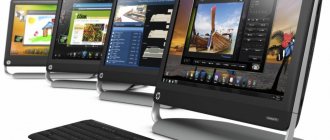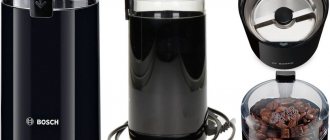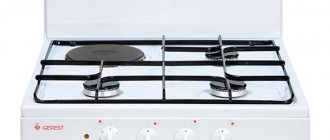The race for compactness continues. Since the middle of the last century, humanity has constantly worked to reduce the size of the computer. At that time, these machines could hardly fit indoors, but over time they were reduced to the size of a slot machine. A few more decades passed, and the PC design was improved to the sizes we are familiar with. The dimensions of the monitors decreased a little longer. However, replacing outdated CRT monitors with thin LCDs was also a matter of time.
However, current desktop computers still lack mobility. Therefore, mass production of analogues for PCs began: nettops, tablets, ultrabooks, all-in-one PCs and laptops. True, only the last two were able to become a full-fledged alternative to desktops. And today we will bring them face to face to understand the difference between them and determine our selection criteria.
So, what is better to choose in 2021 - an all-in-one PC or a laptop? A convenient mobile computer or a computer monitor for the home, without a bulky system unit?
Why is a monoblock an unpopular solution?
There is no need to talk about the popularity of the “monoblock” form factor in our time. The peak of their fame had passed, although the potential was good. All components in one device, saving work space, small size - at first all this attracted buyers. Until all the “jambs” of such a decision began to emerge. Manufacturers have not increased the volume of supplies of monoblocks to the market, and right now the choice among models is small. And those that are on sale mainly represent the highest price segment.
What happened that the form factor lost popularity, a person dreaming of buying an iMac will ask. The main reason is considered to be strong heating of the iron and high operating temperatures of internal components. In addition to the processor, storage and video chip, the display matrix also suffered from heating. There were only 3 possible solutions to this problem:
- Build in an oversized cooling system, which would affect the size.
- Optimize energy consumption by reducing productivity.
- Create innovative but expensive heat removal systems.
And if for expensive products the 3rd option was acceptable, as Apple and Microsoft did, for example, then devices from lower price categories had to say goodbye to performance. Thus, if you buy neither an Apple iMac nor a Microsoft Surface, you will most likely get a simple “office” all-in-one PC that will perform at the same level as a very modest PC. It’s far from certain that it will handle your tasks, especially if it’s working in complex programs.
Differences
- The purpose of the all-in-one computer is a stationary computer for the home, which it is advisable to place once on the table and move it only for wiping dust. It is heavier and bulkier compared to a laptop. You can’t take a candy bar with you and freely carry it in a bag, but a laptop can, it’s designed for that.
- Display – all-in-one PCs are equipped with screens with a diagonal of at least 19 inches, most often 22-25 inches; laptops mostly have displays with a diagonal of 15.6 inches, rarely – 17 inches. Also, when creating a high-quality monoblock, manufacturers place great emphasis on the screen, so expensive panels receive cool IPS matrices with accurate color reproduction, high brightness and color enhancement technologies. In laptops, less attention is paid to the screen. In the MSI line, for example, there are very expensive platforms with weak VA matrices that distort colors when viewed at an angle. But this does not apply to all all-in-one PCs or laptops as classes.
- Input devices - laptops are always equipped with a keyboard and a touchpad that replaces a mouse. Modern transformers (see here for a review of models) in addition have a touch screen - another input device. Most monoblocks are equipped with classic VA or IPS matrices without touch pads; the mouse and keyboard come separately, often with wires. Wireless peripherals will have to be purchased separately. Expensive models at the Apple all-in-one level are equipped with touch screens.
- Autonomy - taking into account the purpose, it is logical to have built-in batteries that ensure operation without a network for 4-5, rarely - 10 hours. Monoblocks in 80% of cases do not have built-in batteries and always operate from the mains. The light goes out - the device turns off; to ensure autonomy, they buy external power supplies, but this is impractical.
- Internal space – in laptops and especially ultrabooks (see model ratings here), the space inside is very limited. This will not allow you to install powerful processors or video cards that get very hot under load. Gaming laptops are equipped with powerful i7-level chips and even new 8th generation processors, but the laptop body becomes thick and uses an extremely efficient and expensive cooling system. Monoblocks have more space inside, which allows the use of more powerful hardware without complex cooling systems. In such systems, the chips heat up less, which in theory increases their service life.
For whom is a monoblock better?
Your immediate goals will determine what is better to buy—a laptop or an all-in-one—specifically in your case. The second option is preferable if you:
- are used to typing text on a full-size keyboard, and not on a small laptop one;
- you work in programs for which a larger diagonal is more convenient;
- do not work in very resource-intensive applications;
- don't play games;
- you don’t have to carry your computer with you;
- spend your leisure time watching movies and videos.
Pros and cons of a laptop over an all-in-one PC
Laptops by their nature are designed for mobile users who use computer resources at home and at work, in the park and at a party, at the desk and in bed. Laptop computers are a minus to performance and a plus to price for the benefit of compactness, which again puts desktop computers in a more advantageous position. This is a regularity - reducing dimensions always forces you to make compromises.
Your laptop can cost $1,500 and be ungodly stupid in a more or less demanding game, or render a project in a resource-intensive application many times longer than it can be done on a PC. But such a computer can be easily carried with you anywhere, performing certain tasks in any conditions. Even if you are going on a long trip, the laptop will not take up too much space in your luggage. Thus, if, when choosing what is better to buy - a laptop or an all-in-one, you understand that you will use the device not only at home - the all-in-one is no longer necessary.
A laptop is about compactness. There is no need to look for a place for a keyboard and mouse; these peripherals are already built into its design. All components are placed into a single “organism”.
A laptop that has a good battery allows its owner to “get rid of the outlet” for a while. In the case of an all-in-one device, this number will not work, since the power here is supplied directly from the mains.
In turn, the small size of the laptop is a blow to multimedia. As noted above, a small screen is not as convenient to work, play or watch video content. Laptops are more convenient for students because they can “go” with you to university or school. The goals are different - sometimes to show a presentation, sometimes to type a summary (you can’t always write by hand).
What's more important:
Let's put together the advantages and disadvantages of laptops against the background of monoblocks.
Pros:
- Mobility and light weight
- Minimal dependence on the outlet
- Wide variety of models on the market
- Possibility to buy a 2-in-1 device (ultrabook, laptop with touch screen)
- High performance in expensive versions
Minuses:
- Fragility (laptops break much more often)
- Battery fragility (after a couple of years it will not hold a charge)
- Small display
- Defective keyboard
- Weak sound from speakers (in most cases)
- No upgrade option
Tips for choosing a candy bar
Despite the fact that many types of technology seem similar to each other, there are still certain nuances. In order to choose the right equipment that will satisfy the owner’s characteristics for many years, you need to consider all the details. At the same time, you should not overpay for functionality that will not be in demand.
How to choose a monoblock?
Screen
The most popular all-in-one monitor size is between 19 and 24 inches. Wider screens are needed for certain tasks and also for gamers. For example, manufacturers also offer monoblocks measuring 34 inches.
Typically, IPS and VA matrices are used in the configuration. Screens made using TN technology are not so common today. IPS matrices are the best option for a computer display. They provide good color reproduction and no distortion at various viewing angles. Monoblocks can have both glossy and matte screen types. The first provides excellent color rendition, but is characterized by high glare. The matte finish of the display has slightly worse color rendering performance, but reflects less glare.
Monoblocks can have both glossy and matte screen types
The touch screen is not installed on all all-in-one models. In this case, everyone determines for themselves the need for this type of monitor. But on a large screen, moving your finger to control the computer is not always convenient.
CPU
One of the most significant disadvantages of monoblocks is the difficulty in upgrading. Therefore, when purchasing, it is important to immediately provide for the possibility of operating the equipment for at least two to three years. The main characteristics of the processor: clock speed, number of cores and its generation.
Video card
The compactness of monoblocks usually does not allow the installation of high-performance chips. But if your computer is required to display high-quality images on the screen, it is recommended to consider cards of at least an average level. These include the GTX 1050, 1070 or RX 560 and Vega 64.
Pay attention to the video card
RAM
Despite the fact that the all-in-one RAM can be expanded, it is nevertheless recommended to immediately select it with a small margin. The RAM type must be DDR4 (the most modern type). The amount of RAM required by the user depends on the purpose of the computer:
- for office: from 4 GB;
- for use as a multimedia device: from 8 GB;
- for games: from 16 GB.
Does volume matter? 4 GB, 8 GB, 16 GB - how many do you need?
It is also recommended to have dual-channel RAM mode in an all-in-one PC. This allows you to significantly speed up the entire computer.
Set of ports for connection
The monoblock must have connectors for connecting peripheral devices. The versatility and functionality of the device largely depends on what outputs the device has for connecting peripherals.
- USB (2.0, 3.0). There should be at least 3 such connectors, allowing connection with many types of equipment.
- Audio output
- Card reader for using various memory cards without an adapter.
- Ethernet, required to connect wired Internet to the all-in-one.
Connectors for connecting peripheral devices
The listed aspects are primarily recommended to be assessed when choosing an all-in-one.
Who is the best laptop for?
To understand what is better - a laptop or an all-in-one computer for home, work, study, games and your other tasks, you need to understand exactly what tasks will be assigned to the computer. Your best choice is a laptop if you:
- you often carry your computer with you to work, school, for walks, etc.;
- travel a lot;
- use a computer in bed;
- in your spare time you like to play games;
- you don’t have free space at home to accommodate a PC or all-in-one;
- let other family members (for example, a schoolchild or student) use the computer and take it with them.
What is cheaper, what is more expensive?
What is cheaper - a laptop or a candy bar? Let's do a little side-by-side comparison. The Lenovo AIO V530-24ICB monoblock model is very popular on the Russian market. In one of its inexpensive configurations (53,710 rubles) you can get an i3-9100T , 8 GB of RAM, 256 GB of internal SSD and an Intel UHD Graphics 630 . We are looking for a laptop with similar technical data. The following models fit these parameters (we’ll compare prices at the same time):
- HP 14s-dq1031ur (RUB 39,300);
- Lenovo IdeaPad S145 (RUB 43,990);
- ASUS VivoBook A512JA-BQ409T (RUB 48,990), etc.
Technically, the difference between these laptop models and the specified all-in-one is only in the display diagonal - 15 inches versus 24, respectively. Of course, you can find laptops with the same data and more expensive than 53 thousand rubles, but we have no intention of overpaying, right?
A considerable part of those who are looking towards all-in-one PCs dream of an iMac as something perfect and without alternative. The 27-inch iMac 2021 will cost you 168,000 rubles in its minimum configuration and almost a quarter of a million in its maximum configuration. A similar laptop, purely in terms of technical characteristics, can be purchased if not 2, then one and a half times cheaper.
Another thing is user experience, the so-called User eXperience. Many will never switch from macOS to Windows for anything in the world, others care about the status of such equipment, and still others will not exchange the appearance and premium materials for which Apple equipment has always been famous.
TOP 3 best all-in-one PCs for home and office
For home use or office employees may need: working with texts and databases, searching the Internet, watching video files, communicating via Skype, etc. High-performance equipment is not required in this case, and the budget may be limited. Several equipment options are offered in a minimum configuration.
No. 3. Lenovo V530-22
Quite budget equipment has an attractive design and excellent “filling”. The all-in-one can be equipped with one of three modifications of Core i3-8100, Core i3-8100T or Core i5-8400T processors. It must be said that the letter “T” means a low level of heat generation, which is of no small importance when operating monoblocks. The computer is equipped with a 21.5-inch matte display.
Lenovo V530-22
Different models of equipment are equipped with TN or IPS matrices (of course, it is recommended to consider the second option, it is more comfortable for the user’s eyes). 4 GB or 8 GB RAM is installed.
Prices for Lenovo V530-22
Lenovo V530-22
No. 2. DELL OptiPlex 7460
The lowest-power monoblock already comes with an i3-8100 processor. RAM, even in the basic equipment, is quite enough (4 GB). The hard drive has a capacity of 0.5 TB. Intel HD Graphics or GTX 1050 cards help you work with video files (they also allow you to enjoy games). The monoblock has a 23.8″ screen with a FullHD matrix. It helps provide excellent brightness, contrast, glare reduction and wide visibility. If desired, you can choose an option with a touch screen.
DELL OptiPlex 7460
An excellent model with a wide choice of configurations has two noticeable disadvantages: the price of monoblocks is very high, and the cooling system is noisy.
Prices for DELL OptiPlex 7460
DELL OptiPlex 7460
No. 1. HP 200 G3 All-in-One
An excellent candy bar is equipped with a matte screen (not touch) with a diagonal of 21.5 "with a resolution of 1920 × 1080, and a quad-core processor. The computer has 4 GB DDR4 RAM. Hard disk capacity - 1 TB. The monoblock has a built-in webcam, acoustics, microphone, card reader, wireless and wired Internet connection. For connecting peripherals there are audio and video connectors, as well as 3 USB ports. The package includes a keyboard and mouse (wired).
HP 200 G3 All-in-One
Does brand matter?
Let's say you have already studied all the pros and cons of laptops or all-in-one PCs, and have decided in favor of a specific form factor. Next comes the choice of brand. Perhaps it would make more sense to consider models from different brands, but almost all of us are accustomed to trusting markings and well-known names.
Apple is ahead of the rest in this regard. External luxury, stable operating system, no brakes or system glitches. They also have excellent displays and a well-thought-out ecosystem that allows you to synchronize many different devices with each other. Those whose budget allows them will most likely choose an iMac or MacBook.
Those who have a more modest budget can pay attention to the brands Lenovo, Asus, Acer and HP. All these companies produce quite good laptops and all-in-one PCs in different price segments. The reputable American company Dell also has its share in the monoblock market. Each company has been producing electronics for many years and confidently maintains its brand. If you have equipment from one of these brands, and it disappoints you, do not rush to hang all dogs on it - there is a place for defects everywhere. Especially if your main focus was saving.










